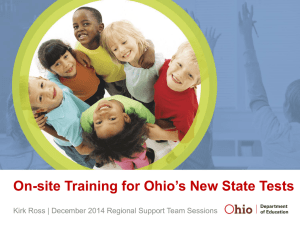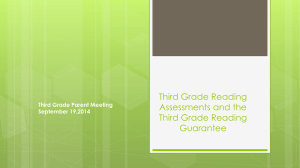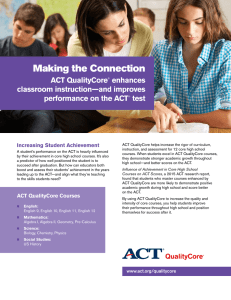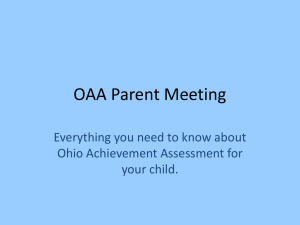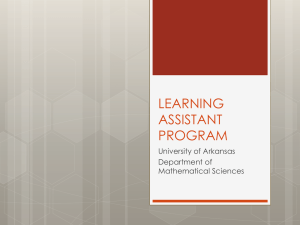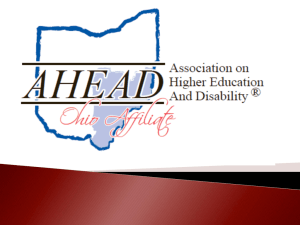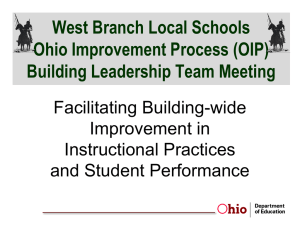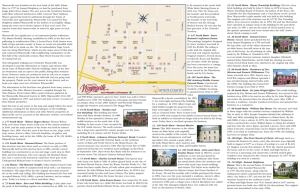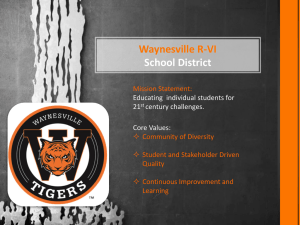HSTW Showcase 2012 - Wayne Local Schools
advertisement
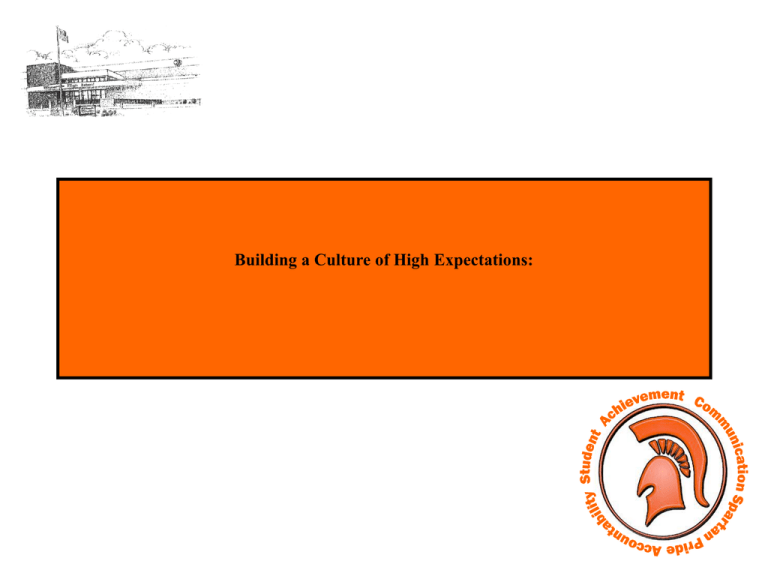
Building a Culture of High Expectations: WLS is part of a small, rural school district in northern Warren County. 865 Students are enrolled at WMS & WHS for the 2011-12 school year with 59 students attending the WCCC. Both Schools have been rated Excellent for the past 8 years. Student Growth Measures Overview Ohio's new system for evaluating teachers will provide educators with a richer and more detailed view of their performance, with a focus on specific strengths and opportunities for improvement. The new system relies on two key evaluation components, each weighted at 50 percent: a rating of teacher performance (based on classroom observations and other factors), and a rating of student academic growth. The challenge for measuring student growth is that there is not a single student assessment that can be used for all teachers. Local education agencies (LEAs) must use data from the state Ohio Achievement Assessment and Ohio Graduation Test when available. If those are not applicable for a given subject or grade, LEAs can choose to use other assessments provided by national testing vendors and approved for use in Ohio. For subjects in which traditional assessments are not an option – such as art or music – LEAs should establish a process to create student learning objectives (SLOs) to measure student progress in those courses. This overview will outline the three types of measures to be included, provide important definitions, and explain the three categories of teachers based on data availability and LEA decisions. HB 153 requires 50 percent of the teacher (and principal) evaluation framework to include measures of student growth. • The student growth component includes multiple measures. • The student growth component includes student growth measures for three categories of teachers based on availability of Teacher ValueAdded and LEA decisions • Teacher-level Value-Added must be included where available (“tested grades and subjects” = reading and mathematics, grades 4-8). • The Ohio Department of Education (ODE) must create an assessment list for measuring growth in “non-tested grades and subjects.” • LEA-determined measures also will be included. • A Student Learning Objective (SLO) process will be utilized for LEA-determined measures. • Data from these measures will be scored based on five levels, comparable to Teacher Value-Added reports, and converted to a score in one of three levels of student growth (Above, Expected, Below). • The student growth component shall be updated as research and best practices emerge. Teacher Performance (50%) • Student • Learning Environment • Content • Assessment • Instruction • Collaboration/Communication • Professional Responsibility and Growth Student Growth Measures (50%) • Teacher Value-Added • Vendor Assessments • LEA-Determined Measures Evaluation Rating • Accomplished • Proficient • Developing • Ineffective Approved List of Assessments Assessment Name Vendor Name Grade(s) / Subject(s) STAR Early Literacy Renaissance PK-3 ELA STAR Math Renaissance G1-3, 9-12 Math STAR Reading Renaissance G1-3, 9-12 Reading Stanford 10 Pearson K-12 Math, English Language Arts, Social Studies and Science Stanford Aprenda 3 Pearson K-12 Math Science, Social Studies, Terra Nova 3 CTB K-12, 1-12 ELA, Math, Science, Social Studies Iowa Assessments Riverside K-12 ELA, Math, Science, Social Studies Riverside Interim Assessments Riverside G 2-11 ELA, Math Performance Global Scholar K-12 ELA, Math, Science iReady Diagnostic Curriculum Associates MAP NWEA MAP NWEA Explore ACT Quality Core ACT ACT ACT PLAN ACT Compass ACT K-8 ELA, Math G 3-10 Science G 2-12 Math Reading, Language Usage G 8-9 ELA, Math, Science G 9-12 End of Course Exams: Algebra I, II, Geometry, Pre-Calculus, Biology, Chemistry, Physics, U S History G 11-12 ELA, Math, Science G 10 English, Reading, Math, Science G 10-12 Writing, Reading, Math The following table describes the three types of student growth measures including certain legislative requirements and LEA options. 1 Teacher Value-Added • • • • • • MUST use if available 10-50% if applicable Phased-in implementation of reading and mathematics, Grades 4-8 Extended reporting (other grades and subjects) being piloted EVAAS Value-Added metric, aggregated across subject areas o 1-year report; or 2- or 3-year rolling average, based on availability 2 Vendor Assessments • • • • • MUST use if LEA has assessment in place 10-50% if applicable and no Value-Added data available • From ODE-Approved List Vendors demonstrate how assessment can measure growth 3 LEA-Determined Measures • • MAY use: LEA decision (Teacher Categories A and B) • 0-40% if used in combination with Type One or Two measures • MUST use (Teacher Category C) • 50% if no Type One or Two data available • Three types of LEA-Determined Measures Student Learning Objectives process for using measures that are specific to relevant subject matter. Measures must be districtapproved and may include: • Locally developed assessments; • Pre/Post assessments; • Interim assessments; • Performance-based assessments; • Portfolios. Shared attribution measures to encourage collaborative goals and may include: • Building or District Value-Added is recommended if available; • Building teams (such as content area) may utilize a composite Value-Added score; • Performance Index gains; • Building- or District-based SLOs. Teacher Category A (with Value-Added) also may use Vendor assessments as an LEA-determined measure if using both. Adoption of Revised Academic Content Standards and Common Core State Standards First steps in our transition to the COMMON CORE in 2010-11: •All 8th grade students will take the Explore in the fall http://www.act.org/explore/ •All 9th grade students will take the Plan during OGT testing http://www.act.org/plan/index.html • Begin to collect baseline data and begin to build a longitudinal look at our population. WHS is going to pilot end of course exams in four courses in Math and English (may not test all students in the course but will give us a sample) – We have been talking to Quality Core. http://www.act.org/qualitycore/index.html •We need to begin the mapping/alignment process and believe that it starts from the top down- remember our target testing with students in regards to ACT will be in the fall and spring of the junior year. Therefore, when looking at vertical alignment we will need to start with and include the middle school – not wait until high school. ACT is 97% aligned to the COMMON CORE. Next steps in our transition to the COMMON CORE in 2011-12: • Assessment Day for all grades 7 - 12 Adoption of Revised Academic Content Standards and Common Core State Standards Next steps in our transition to the COMMON CORE in 2011-12: October Assessment Day - 10/7/11 (Early Release) 7th Grade – Explore (Scored by ACT) 8th Grade – Explore (Scored by ACT) 9th Grade – Plan (Scored by ACT) 10th Grade – Plan (Scored by ACT) 11th Grade – ACT Practice Test (retired version scored internally) 12th Grade - ACT Practice Test (retired version scored internally) ACT Test Date is 10/22/11 Departmental Meetings with WCESC to discuss alignment to newly revised standards 2011-12 Wayne Local Schools College and Career Readiness Model 6th Grade Career Day 7th Grade Kuder/OCIS OAA (Reading and Math) OAA (Reading and Math) Practice Explore (scored by ACT) October Assessment Day Iowa Testing 8th Grade Kuder/OCIS Real World Real Money Mock Interviews OAA (Reading, Science and Math) MMGW Assessment (survey only) Explore (scored by ACT) October Assessment Day 9th Grade Kuder/OCIS Career Day Plan (scored by ACT) October Assessment Day PSAT (not mandatory – moved to Saturday for 2012) 10th Grade Kuder/OCIS Career Day Plan (scored by ACT) October Assessment Day OGT (Reading, Math, Science, Writing, Social Studies) PSAT (not mandatory) 11th Grade Kuder/OCIS Career Day College Day ACT Practice Test (retired version scored internally)- October Assessment Day ACT Test PSAT (not mandatory) 12th Grade Career Passport College Day ACT Practice Test ACT Test (retired version scored internally)- October Assessment Day Freshman Plan 7:35 - 8:35 8:40 - 9:10 9:10 - 9:50 9:50-10:00 10:00 - 10:20 10:25 - 10:50 10:50-11:02 11:02 -11:32 11:35-12:00 12:03 - 12:32 Teachers Burchfield (rm 23) Pardon (rm 28) Stubbs (rm 15) Hardin (SL1) Weirauch (rm 27) Judy /Mandy (rm 25) Sophomores College Readistep Career Section English Math Break Reading Science Collect Test LUNCH 6th Period 7th period 7:35- 8:00 8:00-8:40 8:45 - 9:25 9:25-9:35 9:40-10:00 10:05 -10:25 10:30-11:02 11:02 -11:32 11:35-12:00 12:03 - 12:32 24 23 24 24 24 Teachers Helleman (SL2) Curlis (rm 21) Clark (SL 3) Lewis (mac) Molly (art) 9 128 Answer Document Reading Writing Break Math w/Calc Math wo/Calc Collect test LUNCH 6th Period 7th period 24 22 23 24 9 102 Foley - Sub/Bathroom Gabbard / Philpot - Hallway Juniors and Seniors ACT 7:35 - 8:00 8:00 - 8:45 8:50 - 9:50 9:50 - 10:00 10:00 - 10:35 10:40 - 11:15 11:20 - 11:50 11:50-12:02 12:02 - 12:32 Teachers Hoehner (rm 22) Stupp (rm 16) Polz (rm 14) Schleman (rm 13) Syvertsen (rm 26) Frost (rm 18) Langford (rm 17) Answer Document English Math Break Reading Science Writing Collect test Lunch Hamen (rm 12) Rivero (rm 24) Lueth (media) Lunch at 12:32 Lunch at 12:32 Lunch at 12:32 Lunch at 12:32 21 20 20 20 22 20 20 20 21 8 19 2 District Objective – Student Achievement/ Accountability Lexile.com The Lexile Framework for Reading Matching readers with texts http://www.thereadingwarehouse.com/DEV/search.php?Lexile=1290 http://www.lexile.com/about-lexile/lexile-overview/ http://www.lexile.com/analyzer/ “Typical” Reader – Lexile measures by Grade: Grade 1 Up to 300 L 2 140 - 500 L 3 330 - 700 L 4 445 - 810 L 5 565 - 910 L 6 665 - 1000 L 7 735 - 1065 L 8 805 - 1100 L 9 855 - 1165 L 10 905 - 1195 L 11&12 940 - 1210 L ACT has established progressive Lexile Ranges aligned to College and Career Readiness Expectations for all students: Grades 2-3 4-5 6-8 9-10 11-CCR 450 – 790 L 770 – 980 L 955 – 1155 L 1080 – 1305 L 1215 – 1355 L 6 LA Oceans cover more than two-thirds of our planet. Yet, just a small fraction of the underwater world has been explored. A new project aims to shed additional light on the ocean depths. Scientists at the Woods Hole Oceanographic Institution (WHOI) in Massachusetts are building an underwater vehicle that will carry explorers as deep as 6,500 meters (21,320 feet). The new machine, known as a manned submersible or human-operated vehicle (HOV), will replace another one named Alvin, which has been operating for 40 years but can go down only 4,500 meters (14,764 feet). Based on the amazing results of Alvin’s explorations, there’s plenty more down there to be discovered. 6 LA A Portrait of Adult Reading Demands • • • • Community College Textbooks (1200L‐1370L) University Textbooks (1300L‐1480L) SAT/ACT/AP Test Materials (1105L‐1205L) GRE Test Materials (1325L‐1440L) What does the Data Show??? Correlation between ACT Explore® and Grade 8 OAAs The ACT Explore® test is often given to 8th grade students as a means of seeing how prepared these students are for high school and beyond. There is typically not a lot of understanding of the content that goes into the ACT tests, and often times no further analysis is done in terms of the group performance on the test compared with the Ohio Achievement Tests. At the request of a SW Ohio district, I undertook a correlation study between student performance on the ACT Explore test and the subsequent OAA tests taken by the same students about 5 months after the Explore test. Before presenting the data, I think it is important to explain what a correlation coefficient is. Often denoted by the symbol r , a correlation coefficient looks at two variables for the same student and determines the degree of linear connection between the two of them. When dealing with data from human subjects, like test results, the following table is helpful for interpreting r values. r value Correlation None Small Medium Strong 0.0 to 0.09 0.1 to 0.3 0.3 to 0.5 0.5 to 1.0 Here is the table of r values for the correlations calculated for this district’s 8th graders. The scaled score values for both tests were used. OAA test ACT Explore® test r value Reading Reading 0.64 Reading English 0.75 Math Math 0.77 Science Science 0.52 You can see from the two tables that there definitely exists a strong correlation between the achievement levels of students taking both of these tests. Of the four comparisons, the science correlation appears to be the weakest. My proposed explanation for this is that the Explore Science test is almost exclusively a Science Process skills test versus the OAA which is heavily content knowledge driven. Even still the correlation is in the strong category. This gives the Explore test diagnostic value for the OAAs. If the results are received with time prior to the OAA administration interventions could be made. ACT’s College Readiness Benchmarks Test EXPLORE PLAN ACT English 13 15 18 Mathematics 17 19 22 Reading 15 17 21 Science 20 21 24 Classes of 2016 and 2017 Class of 2015 at or above benchmark (2010-11 Explore Results) 90% ACT’s College Readiness Benchmarks 84% 80% 66% 70% 61% Test English Mathematics Reading Science EXPLORE 13 17 15 20 PLAN 15 19 17 21 ACT 18 22 21 24 62% 60% 50% WMS 36% 40% National 36% 27% 30% 20% 10% 10% 0% English Math Reading Science We will divide our students into three groups: those who are ON TARGET (met or exceeded the College Readiness Benchmarks) those who are NEARLY ON TARGET (within 2 or fewer score points of meeting each Benchmark) those who were OFF TARGET (more than 2 score points from meeting each Benchmark). Class of 2014 at or above benchmark (2011 Plan Results) Achievement 90% 80% 70% 77% 68% 62% 60% 50% 50% WHS 42% 40% National 34% 29% 30% 22% 20% Growth 10% 0% English Math Reading Science District Objective – Student Achievement/ Accountability Class of 2014 Plan Results (2011) Achievement 80% 72% 70% 58% 60% 51% 50% Growth On Target 41% 38% 40% Nearly on Target 30% 25% 21% 20% Individual Benchmarks those who are ON TARGET (Plan score of 20 or above) those who are NEARLY ON TARGET (Plan score of 18-19) those who were OFF TARGET (Plan score of 17 or below) 15% Not on Target 27% 22% 17% 13% 10% 0% English Math Reading Science Gender Grade Comp (Iowa 2009) Composite (Plan 2011) Projected ACT Goal - Comp Score of 24 (20 and above) M 9 98 25 26-30 M 9 21 22-26 F 9 20 21-25 M 9 20 21-25 M 9 21 22-26 On Target On Target On Target On Target On Target 92 Gender Grade Comp (Iowa 2009) Composite (Plan 2011) Projected ACT Goal - Comp Score of 24 (18 or 19) F 9 76 18 19-23 F 9 76 18 19-23 M 9 70 18 19-23 M 9 79 18 19-23 F 9 68 18 19-23 Nearly on Target Nearly on Target Nearly on Target Nearly on Target Nearly on Target Gender Grade Comp (Iowa 2009) Composite (Plan 2011) Projected ACT Goal - Comp Score of 24 (17 and below) M 9 68 16 16-20 F 9 13 13-17 F 9 50 17 17-21 F 9 65 15 15-19 F 9 90 17 17-21 Not on Target Not on Target Not on Target Not on Target Not on Target District Objective – Student Achievement/ Accountability Average Final QualityCore Algebra I Score: 145 Final Scale Score Range 125-175 Quality Core – End of Course Exam Average Final QualityCore Geometry Score: 145 Final Scale Score Range 125-175 Subscores -- Points Received / Possible Points Exploring Expressions, Equations, and Functions in the First Degree 12 Exploring Other Nonlinear Equations and Functions 6 Exploring Quadratic Equations and Functions 3 28 12 Comparing Geometric Figures 6 14 Logic and Proof 5 14 Measurement/Coordinate Geometry/Trigonometry 8 14 Number Sense, Operation and Graph Skills 7 Subscores -- Points Received / Possible Points 18 Properties of Geometric Figures 10 16 Received Points Possible Points Average Final QualityCore Algebra II Score: 144 Final Scale Score Range 125-175 Received Points 14 Nonpolynomial Functions 5 14 Number Sense and Operation Skills and Quadratic Functions 6 14 Polynomial Functions 6 14 Probability, Sequences, and Series 6 Possible Points Average Final QualityCore Precalculus Score: 150 Final Scale Score Range 125-175 Subscores -- Points Received / Possible Points Linear Functions 5 24 Subscores -- Points Received / Possible Points Conic Sections; Advanced Functions 12 19 Polar Coordinates and Vectors 8 14 Polynomial Functions; Sequences and Series 7 17 Trigonometric and Periodic Functions 11 20 14 Received Points Received Points Possible Points How will you measure success/growth? Possible Points Quality Core – End of Course Exam District Objective – Student Achievement/ Accountability Average Final QualityCore English 10 Score: 154 Final Scale Score Range 125-175 Average Final QualityCore English 9 Score: 152 Final Scale Score Range 125-175 Subscores -- Points Received / Possible Points Subscores -- Points Received / Possible Points Critical Reading 8 Critical Reading 7 13 Essay 9 Mechanics of Writing 2 12 Essay 10 24 Mechanics of Writing 4 5 24 6 Reading Comprehension 12 Reading Comprehension 12 17 17 Received Points Received Points Average Final QualityCore English 11 Score: 156 Final Scale Score Range 125-175 Average Final QualityCore English 12 Score: 154 Final Scale Score Range 125-175 Subscores -- Points Received / Possible Points Subscores -- Points Received / Possible Points Critical Reading 9 Critical Reading 12 15 6 5 Reading Comprehension 9 Reading Comprehension 10 24 24 Mechanics of Writing 4 Mechanics of Writing 4 16 Essay 12 Essay 14 Possible Points Possible Points 13 15 Received Points Received Points Possible Points Possible Points What does the Data Show??? Writing Math Social Studies Science Reading OGT Seven Year Study 2005 - 2011 Percentage of students who passed the OGT on the first attempt 100% 93% 90% 90% 83% 78% 80% 70% 79% 76% 69% 60% 50% 40% 30% 20% 10% 0% All 2005 All 2006 All 2007 All 2008 All 2009 All 2010 All 2011 Waynesville High School Ranked 24th in the State of Ohio!!!! WHS is ranked 24th on the list of high schools released by the Ohio Department of Education. This places WHS in the top 3-4% of the high schools in OHIO (753). WHS is also ranked 54th on the list of ALL schools (K-12) and places WHS in the top 1.5% of ALL schools in OHIO (3440). Performance Index Score 2010-11 114.6 114.1 114 113.5 113.4 112.7 112.5 112.4 112.2 112.2 112 Building Name District Name Solon High School Oakwood High School Dublin Jerome High School Minster High School Turpin High School Hudson High School Toledo Early College High School Rocky River High School John Hay Early College High School Aurora High School Olentangy Liberty High School Solon City Oakwood City Dublin City Minster Local Forest Hills Local Hudson City Toledo City Rocky River City Cleveland Municipal Aurora City Olentangy Local Indian Hill High School Indian Hill Exempted Village Reynoldsburg High School eSTEM Madeira High School William Mason High School New Albany High School Walnut Hills High School Mariemont High School Chagrin Falls High School Wyoming High School Springboro High School Reynoldsburg City Madeira City Mason City School District New Albany-Plain Local Cincinnati City Mariemont City Chagrin Falls Exempted Village Wyoming City Springboro Community City 111.9 111.9 111.9 111.8 111.8 111.7 111.7 111.4 111.1 Upper Arlington High School Ottawa Hills High School Waynesville High School Upper Arlington City Ottawa Hills Local Wayne Local 111 111 110.8 Versailles High School Versailles Exempted Village 110.7 112 What will you do this year to ensure ALL students experience success and growth? District Objective – Student Achievement Performance Index The Performance Index (PI) is a calculation that measures achievement/OGT test performance at the 3rd, 4th, 5th, 6th, 7th, 8th, and 10th (OGT) grade levels based upon the number of students at each performance level. The PI is calculated by assigning a weighted score to each performance level in the following manner: • Untested students - 0 points • Below Basic/Limited - 0.3 points • Basic - 0.6 points • Proficient - 1.0 points • Accelerated – 1.1 points • Advanced - 1.2 The percentage of students at each performance level is then multiplied by their respective weight, and the totals for each performance level are summed to get the building’s overall Performance Index score. Gap Analysis Used for Student Achievement/ Benchmarks District Objective – Student Achievement How will you measure success/growth? ACT Benchmarks and Goals SUBJECT NUMBER TESTED Solon City SD Reading 472 Waynesville Reading Solon City SD Waynesville PERCENT PROF. OR ABOVE PERCENT ADV. PERCENT ACCEL. PERCENT PROF. PERCENT BASIC PERCENT LIMITED PERCENT Adv + ACC 99.2 66.9 24.8 7.4 0.6 0.2 91.7 128 97.7 39.1 33.6 25 1.6 0.8 72.7 Mathematics 472 98.5 81.1 13.1 4.2 0.6 0.8 94.2 Mathematics 128 94.5 64.8 23.4 6.3 3.1 2.3 88.2 Solon City SD Writing 472 98.5 10.4 76.9 11.2 1.1 0.4 87.3 Waynesville Writing 128 97.7 0.8 75.8 21.1 0.8 1.6 76.6 Solon City SD Science 472 97.7 60.8 22.5 14.4 1.7 0.6 83.3 Waynesville Science 128 94.5 46.1 22.7 25.8 3.9 1.6 68.8 Solon City SD Social Studies 472 99.2 82.2 10 7 0.2 0.6 92.2 Waynesville Social Studies 128 94.5 70.3 12.5 11.7 3.1 2.3 82.8 Solon City SD All Five 472 97 Waynesville All Five 128 90.6 School Five-Year School Score Summary (2011) % of Students at WHS with a score of a “3” or above Waynesville High School Ohio Global What does the Data Show??? 6/7/8 Reading 8 Science 6/7/8 Math OAA DATA 2007 - 2011 WMS Performance Index WMS OAA Summary Results % Proficient 2007 2008 2009 2010 2011 6 Reading 94 87 92 92 96 6 Math 91 95 96 92 93 7 Reading 90 89 90 96 85 7 Math 84 84 94 90 84 7 Writing 96 95 91 NA NA 8 Reading 94 94 95 93 96 8 Math 88 83 92 84 90 8 Science 87 83 91 90 88 8 SS 85 86 89 NA NA WMS OAA Summary Results % Accelerated Advanced 2007 2008 2009 2010 2011 6 Reading 50 54 50 58 62 6 Math 66 72 67 84 66 7 Reading 45 48 53 57 52 7 Math 31 32 38 51 46 7 Writing 64 74 54 NA NA 8 Reading 58 70 63 65 73 8 Math 29 43 50 45 43 8 Science 56 44 65 63 61 8 SS 62 61 72 NA NA Components to help the teacher improve Student Achievement Staff Development and Improvement Staff Development Opportunities linked to the following: • Promoting rigor/relevance and student engagement in the classroom. (MSTR) • The Big Idea – part of connection. (HSTW – MSTR) • Rigor/Relevance Framework http://www.leadered.com/rrr.html • Real World predictable and unpredictable situations. • • • Technology – engage, enrich, and re-teach. Real world examples – 21st Century Skills. Web page development, smartbaords used as smartboards, teacher/student resource, STEM. ACT Alignment –ACT Curriculum Review, reading comprehension assessments S M A R T Goals - Goal meeting’s in September – 6-12 department meetings during late arrivals. 2010-11 Professional Development linked to District Objectives Reading, Writing and Thinking 47 Minutes of Learning HSTW Formative Assessments Marzano - Acquisition of Vocabulary – Building Background Knowledge RttT Using data to improve classroom instruction (value-added, formative assessments) Innovative opportunities and models for Ohio’s schools and education leaders Expanding effective educator preparation programs Integration of the new Content Standards and Model Curricula into the classroom Research-based high quality instructional practices Teacher evaluation systems that integrate student growth measures Ohio Principal and Teacher Evaluation Systems Short Cycle Assessments Laura Robb – Reading and Writing Strategies Collins Writing HSTW Focus Groups Professional Learning Communities Blooms , Blooms, Blooms…… WMS Extra Time/Extra Help The definition of INSANITY is doing the same thing over and over again and hoping for different results. Essential Questions: Who is the customer? What will you do this year to ensure ALL students experience success????? How do you determine success in your classroom/school???? How will you measure success? What will you do if students are not successful? “What does a Waynesville High School Graduate look like???” 99% will have graduated in 4 years (86.9 state ave.) Senior Year 58% participate in Athletics 95.4% participated in Fine Arts Average credits earned = 24.9 35.2% have taken an AP course ACT Ave. score – 21.5 29% will earn a Honors Diploma Average GPA - 3.029 Top 4 Majors 1. Bio/medical 2. Nursing 3. Education 4. Criminal Justice 31.4% will have earned College Credit through: AP, PSEO or Dual Credit 93% passed the OGT on the First Attempt 16.5% will go into the workforce Each will earn $7929.00 in scholarships 1.8% will go into the military 58.7% will attend a four year college/university (12% out of state) 24.7% will attend a two year college/university Building a Culture of High Expectations:
